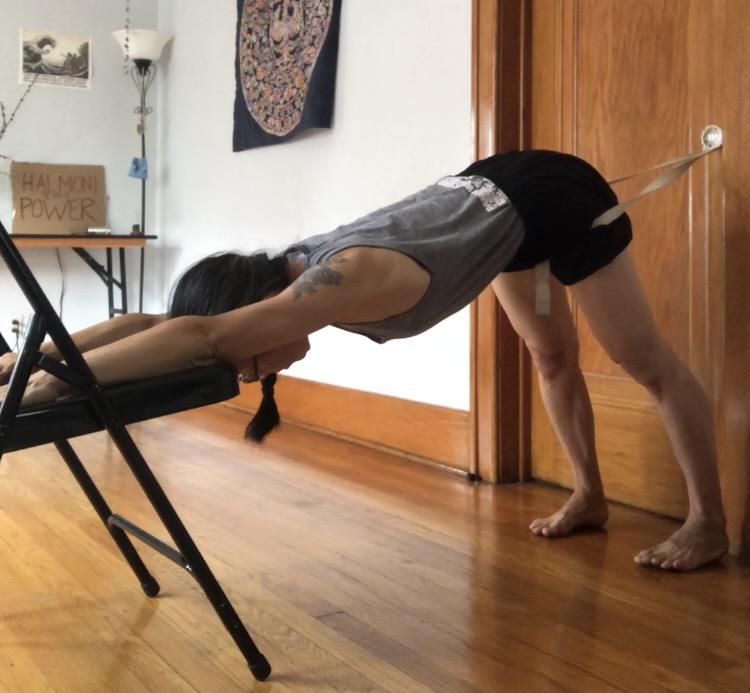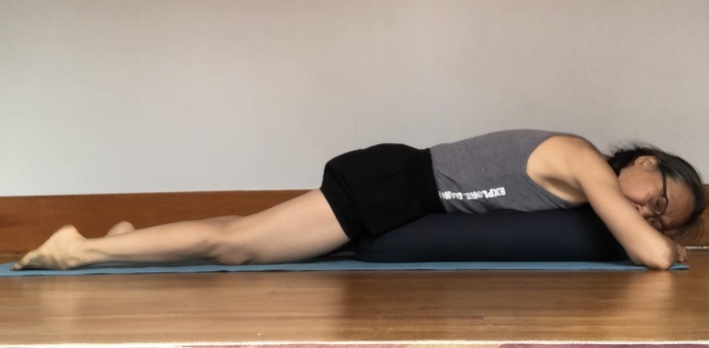Everywhere we go, we encounter folks with back pain. It seems to be a hallmark of this time and place. I have also experienced back pain on and off over the years, but these days, hardly ever. If I do throw something out, get a catch, wake up with a twinge, jam my sacrum, or pull a muscle, I put everything on hold until I work that kink out.
One of my quirky, outrageous rules is: I tolerate pain for only one day. In other words, the next day, it'd better be gone! How do I make this happen? I am extremely blessed to have studied Iyengar Yoga therapeutics with some of the best teachers in the world. Over the years I've developed quite an extensive therapeutic repertoire, and am grateful to hundreds of students who've helped me hone my knowledge and skills. I'm also grateful to my own body for teaching me how to heal myself. I've personally experienced neck and shoulder pain, knee pain, menstrual and menopausal issues, low back pain, sacral instability, groin pain, hip pain, plantar fascitis, sciatica, sprained ankles, and more! Each time, I've had to figure out how to heal myself. I've had lots of assistance and guidance from Senior Iyengar Yoga Teachers, especially Lois Steinberg, as well as peers and colleagues. I also embrace the spirit of experimentation and improvisation to figure out what works on a given day.
I published the following Low Back Health sequence back in 2021 in Iyengar Yoga Detroit Collective's Wellness 'Zine. I'm republishing the photos now because several people in recent weeks and months have talked to me about their intermittent or chronic back pain. I invite anyone who is experiencing back pain to try these poses out. They can all be done at home with simple props. Look around your home and find what you can use. Improvise and modify as needed. Every pose should feel wonderful. If it doesn't, come out of the pose and modify it. If you cannot find a modification that brings relief, consult a CIYT. Do this sequence as often as you like, even daily, and please let me know it goes.
1. Low back Śavāsana
Lie on your back and rest your calves on a chair seat. This helps lengthen the buttocks away from the waist so that the sacrum and low back widen and the back muscles can soften and spread. If you wish, you can even lay a bolster across your abdomen and ask a helper to put plate weights (25 lbs) or sandbags on it. This will further relax the low back muscles. Stay for 5 minutes minimum, or as long as you wish.
2. Pavanmuktanāsana
Have 2 chairs facing each other, and lay an 8-fold sticky mat over them. Stack 2 bolsters or thick pillows/cushions on them, staggered. Place a block on the end so that the top bolster stays level. Support the head with a blanket. The hips should be higher than the knees, so that the front groins can soften, you can easily fold forward, and lengthen the trunk. This pose further brings quietness and ease while allowing the low back to keep spreading. Stay 5 minutes or longer.
3. Adho Mukha Śvanāsana with traction
Here, a yoga strap is secured to a doorknob, then circling the top of the thighs while the heels move back toward the door. The arms reach forward onto a chair seat so that the spine can fully lengthen. Notice the angle between the trunk and the legs is wider than 90°, to facilitate full spinal length. Stay 2-3+ minutes, repeating as desired.
4. Chaturangāsana





No comments:
Post a Comment